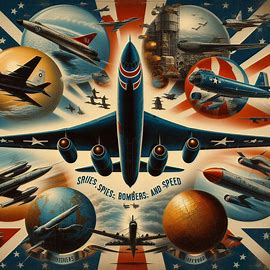
Introduction
The Cold War was not just a standoff of ideologies—it was a battle for supremacy in the skies. From the end of World War II to the fall of the Soviet Union, aircraft evolved at a breakneck pace. Spies flew at the edge of space, bombers carried doomsday weapons, and interceptors were built to counter every conceivable threat. In this article, we explore the most iconic and influential Cold War aircraft that defined military aviation from 1947 to 1991.
1. The Strategic Landscape of the Cold War
1.1 Airpower as a Deterrent
The Cold War was dominated by the threat of nuclear annihilation. Aircraft were essential tools in maintaining the balance of terror. Strategic bombers, capable of delivering nuclear payloads, formed the backbone of deterrence policies.
- Mutual Assured Destruction (MAD): A concept reliant on second-strike capability
- Strategic Air Command (SAC): The U.S. Air Force’s global strike arm
- Soviet Long-Range Aviation: Counterpart to SAC with heavy bombers like the Tu-95
Aircraft ensured that any nuclear attack would be met with swift, devastating retaliation.
1.2 The Emergence of Jet Propulsion
Post-WWII aviation saw the introduction of jet engines, leading to faster, more capable aircraft. Jet fighters replaced propeller-driven planes, and new roles like aerial reconnaissance and electronic warfare were developed.
- Speed became essential to outmaneuver both detection and destruction
- Altitude records were shattered, with some jets flying near the edge of space
This new jet age redefined the possibilities of aerial warfare.
2. Espionage in the Sky: Reconnaissance Aircraft
2.1 Lockheed U-2
The U-2 was designed for high-altitude reconnaissance over Soviet territory.
Specs:
- Ceiling: 70,000+ ft
- Speed: 500+ mph
- Range: 3,000 miles
Famous Incident:
- 1960 U-2 shootdown over USSR, piloted by Francis Gary Powers
- Sparked a major diplomatic crisis between the U.S. and USSR
The U-2 remains in use today due to its unique high-altitude capabilities.
2.2 SR-71 Blackbird
The SR-71, also from Lockheed’s Skunk Works, pushed the envelope of speed and stealth.
Specs:
- Speed: Mach 3.3
- Ceiling: 85,000 ft
- Range: 2,900 miles (unrefueled)
Unique Features:
- Titanium airframe to withstand high temperatures
- Could outrun surface-to-air missiles
The SR-71 remains the fastest air-breathing manned aircraft ever built.
3. Strategic Bombers: Engines of Destruction
3.1 Boeing B-52 Stratofortress
Introduced in the 1950s, the B-52 became the face of American airpower.
Specs:
- Range: 8,800 miles
- Payload: Up to 70,000 lbs
- Speed: 650 mph
Roles:
- Nuclear delivery
- Conventional bombing (Vietnam, Gulf War)
- Stand-off missile platform
The B-52 is still in service today, a testament to its durability and adaptability.
3.2 Tupolev Tu-95 “Bear”
The Soviet answer to the B-52, the Tu-95 combined turboprop engines with long range.
Specs:
- Speed: 575 mph
- Range: 9,400 miles
- Payload: ~33,000 lbs
Key Features:
- Counter-rotating propellers
- Long patrol endurance
Despite its vintage design, it remains a key element of Russia’s strategic aviation.
3.3 Northrop B-2 Spirit
Though it entered service at the end of the Cold War, the B-2 was a product of Cold War fears.
Specs:
- Stealth design with radar-absorbent materials
- Range: 6,900 miles unrefueled
- Payload: 40,000 lbs
Strategic Role:
- Penetration bomber capable of infiltrating deep into enemy territory undetected
The B-2 changed the strategic bomber paradigm through stealth rather than speed.
4. Fighters and Interceptors: Supersonic Guardians
4.1 MiG-21 Fishbed
One of the most produced fighters in history, the MiG-21 served numerous nations.
Specs:
- Speed: Mach 2
- Range: 1,200 miles
- Armament: Cannon and air-to-air missiles
Combat Use:
- Vietnam War
- Middle East conflicts
- Indo-Pakistani wars
It was fast, relatively cheap, and easy to maintain, making it a Cold War staple.
4.2 F-4 Phantom II
A U.S. multi-role fighter used by Navy, Air Force, and Marines.
Specs:
- Speed: Mach 2.2
- Payload: Over 18,000 lbs
- Avionics: Early radar and electronic countermeasures
Engagements:
- Vietnam War
- Arab-Israeli conflicts
Its adaptability made it one of the most successful fighters of the Cold War.
4.3 English Electric Lightning
Britain’s answer to high-speed interception.
Specs:
- Speed: Mach 2.0+
- Climb rate: 50,000 ft/min
Unique Aspect:
- Vertical twin-engine layout
- Interceptor capable of reaching altitudes above 60,000 ft quickly
Though limited in range, it was highly respected for its performance.
5. The Role of Technology and Innovation
5.1 Radar and Missile Integration
Radar-guided missiles revolutionized air combat.
- Beyond Visual Range (BVR) combat became viable
- Missiles like the AIM-7 Sparrow and AA-2 Atoll dominated engagements
Jet fighters were no longer limited to dogfighting alone.
5.2 Electronic Warfare (EW) and Countermeasures
Aircraft were equipped with jammers, radar warning receivers (RWR), and decoys.
Examples:
- ECM pods on B-52s
- Wild Weasel variants of the F-105 and F-4 for SEAD missions
EW became critical in both offensive and defensive roles.
5.3 The Rise of Stealth
Stealth technology emerged in the 1980s and was epitomized by aircraft like the F-117 Nighthawk.
- Reduced radar cross-section allowed surprise attacks
- Precision-guided munitions increased lethality
Stealth shifted the focus from speed and altitude to survivability and precision.
Conclusion: Sky Warriors of a Cold Era
Cold War aircraft weren’t just machines—they were symbols of power, deterrence, and the high-stakes chess match between superpowers. Whether it was the B-52 circling in airborne alert, the SR-71 racing over hostile territory, or the MiG-21 taking on NATO jets, each aircraft played a unique role in shaping military history.
These legends of the sky paved the way for modern airpower doctrine and inspired generations of aerospace innovation.